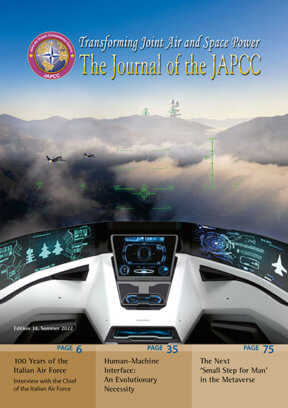Introduction
‘The fighter jet era has passed.’ These words were famously spoken by Elon Musk at the 2020 Air Warfare Symposium when prompted to describe the future Air Domain.1
Musk’s position appears to be supported by the Defense Advanced Research Projects Agency (DARPA) Alphadogfight (ADT) demonstrations.2 During ADT, several Artificial Intelligence (AI) projects faced off against each other in a dogfight tournament. The winning AI then went face-to-face against a human fighter pilot. While DARPA asserts the competition intended to develop AI processes supporting human pilots in a human-machine symbiosis,3 the result could not have been worse for the pilot himself. The human lost every engagement against the machine and lost quicker than the AI’s previous machine adversaries.
It is also worth considering how a Beyond Visual Range scenario – in which the computation of distances, knowledge of the relative position of aircraft, relative heights, speeds, and weapons all have to be done at very high speeds – would have turned out. Considering the complexity of air-to-air tactics and the prominent role of deception and electronic warfare in their conduct,4 the result might have been even more alarming.
Nevertheless, many aircraft manufacturers continue to develop manned combat aircraft.5 Even the cost-driven commercial airline sector is unlikely to replace human pilots.6 Furthermore, albeit western 5th Generation fighters are all single-seat aircraft, even for training purposes, two-seat designs are back on the table. Recently, images have surfaced of the Chinese 5th Generation J-20 fighter7 in a two-seat configuration, and Sukhoi is contemplating a two-seat version of its Su-75 Checkmate.8 The reasons behind the return to two-seat designs remain opaque, but given the complexity of current air operations and the anticipation of more complex Multi-Domain Operations (MDO), the next generation may benefit from a Weapons System Officer.
Alternatively, DARPA’s Air Combat Evolution (ACE) programme envisions a middle ground where human pilots trust the AI to control the aircraft while they command the mission through tasks requiring human judgement or responsibility such as deciding on the engagement strategy, selecting and prioritizing targets, and determining the best weapon or effect.9
The future will almost certainly include the AI advantages asserted by Musk and anticipated by DARPA, but should they accompany or replace the human pilot? Numerous challenges remain. This article will highlight the most important.
Challenges and Considerations
Machine-Learning Process
The most common machine learning method supporting AI is Reinforcement Learning (RL),10 which enables a computer algorithm to learn by itself from past events. The machine uses a reward system to discriminate between successful and unsuccessful moves, and it can be performed quickly, in an unguided way, without human interaction. At the same time, a human can also point out mistakes and help to reinforce future courses for the machine to seek success.
Reward Shaping11 is another machine learning technique that complements RL by accelerating learning outcomes through assigning relative values to transactions. This concept incentivizes AI to move to a higher-paid status by exploiting what it has already learned about the ‘value’ of its previous choices. This valuation enables the AI to conduct risk versus reward calculations while exploring a range of actions in pursuit of higher rewards. The objective is to reach a good trade-off after exploring all the possible solutions and rewards.12
An additional advantage that may accelerate the learning process is that AI systems can build on other AI systems’ experience, using additional machines to train within the desired network without human involvement and transferring gained knowledge to a target machine. Several simulators, each applying different tactics, could dramatically accelerate the learning process.
However, machine learning should not be seen as a panacea. It is still highly dependent on software design, algorithms, and data choices. Incomplete or insidious information incorporated within the machine learning technique can lead to significant deficiencies or errors in the learning process. As a result, AI could make ineffective or dangerous decisions.
Control of the Aircraft
Although the trend is for AI to aid the pilot only if the ACE programme shows that AI flies better, how will both options be merged in a real fighter aircraft?
One option is for the plane to be controlled by a human pilot and only advised by the AI, at least until the machine recognizes a critical risk and assesses that it can respond faster or better than the human. Should the human pilot always retain control over this decision or should the AI be authorized to take control without pre-authorization to ensure mission success or aircraft survival? Similarly, should the pilot take all weapons employment actions knowing that his reaction time implies the loss of critical seconds that could compromise positioning or shot opportunity?
Additionally, not being at risk of losing consciousness at the extremes of the aircraft’s manoeuvring capabilities is one of the compelling advantages AI has over a human pilot. While it is anticipated that AI could incorporate data on the pilot’s health status, the only way to gain an advantage against an adversary could be at the expense of the pilot’s consciousness. With an unconscious pilot, should the AI employ weapons autonomously?
Furthermore, since fighter aircraft traditionally operate in two- or four-ship formations, decisions about human versus AI control will affect both the individual aircraft and the entire flight. Consideration is required for how an AI-controlled aircraft communicates with the other formation’s aircrews and whether it is done via datalink, voice, or both. Given the possibility that some, but not all, aircraft in a flight are under AI control – and potentially with unconscious pilots – should the control of the entire formation be delegated to AI or should it be transferred to any conscious pilot?
A more straightforward option is to constrain the AI into an aide role to provide the appropriate information at the precise moment to avoid saturation and, perhaps, in particular circumstances such as when needed for survival, take command of the plane as the extant fly-by-wire systems do when angle-of-attack limits are exceeded or in certain out-of-control situations.
As of today, due to its considerable complexity, the most likely evolution is for AI to simply help the pilot. However, as technology evolves quickly we should certainly not avoid AI’s support, especially knowing that potential adversaries will use it extensively.13
Ethics
Many authors have written about the moral and ethical aspects of robotic-autonomous and AI-controlled weapons systems and have explored whether we should allow machines to make life or death decisions regarding humans. A particular case to assess ethically is that of AI overriding the control of the human pilot. Some consider that a fully developed AI will be responsible and legally accountable for its decisions and the consequences. In contrast, others believe that at least one human must retain responsibility and legal accountability.14 Who would be responsible if an AI-controlled aircraft makes an error that leads to the loss of human lives? It could be considered that the human pilot, even if he might have had no chance to intervene or cancel the action, or even the programmer but, most probably, the commander that ordered the mission will be the responsible one.15
Accurate Intelligence and AI-Derived Tactics
Intelligence-derived data will provide the basis for the AI learning process. It is anticipated that AI will process all sensor data available to an aircraft, its flight members, and perhaps a much broader cloud-networked system of systems. In real time, this will support decision advantage for the individual aircraft and enable a significant ability to propose and evaluate tactics during test and evaluation events.16 However, just as data alone does not equate to accurate intelligence, data alone will not create new tactics either. Human judgement interprets the data, infers adversary capabilities and tactics, creates the test environments, and evaluates the results. The accuracy of these human choices will inevitably impact AI-derived tactics just as in conventional tactics development. Here, AI’s ability to run massive sets of simulations should be leveraged to provide a wide range of potential options to deal with unforeseen adversary capabilities and tactics.
Where Will AI Be Located?
When we think of AI-Human symbiosis in a fighter aircraft, R2D2, Luke Skywalker, and the X-Wing fighter from Star Wars inevitably come to mind. However, where will the AI be in real fighters? Will it be on the aircraft or in a cloud? Would the cloud-AI overcome the communications latency to gain an advantage over a human in a dogfight? Dislocating the AI or the pilot implies risks that should be minimized, knowing that advantages in communications are never absolute nor permanent.
To set expectations, it should be noted that ADT used a rack of computers and servers to process live data provided by the human-piloted fighter. Such computing power and the enabled data supremacy cannot currently be incorporated in a fighter jet.
How Will the AI ‘Feel’?
In the ADT contest, the human pilot used a high-fidelity Virtual Reality system to track the AI-piloted adversary aircraft visually. However, since the digital smart model used in the competition lacked sensors, the AI received all adversary data as a direct input, relieving the more complex tasks such as sensing and interpretation. The use of accurate data about the opponent’s flight parameters brought a significant advantage to the machine. This data in actual combat is not easy to obtain and, when gathered, is not always accurate. Human pilots have to infer an opponent’s parameters, complicating the interpretation and the decision-making. AI agents will have to do the same.
To that end, AI will need more than just the information available to the pilot (including radar, warning receivers, infrared sensors, and data links) to ‘feel’ and maintain situational awareness. AI will need a suite of visual sensors similar to those incorporated in self-driving cars to enable equivalent visual lookout as is currently accomplished by human pilots. While it is anticipated that AI will be faster at interpreting properly integrated sensors – no small feat in itself – it remains to be seen how well the AI will respond to unanticipated or anomalous situations ‘where feeling or intuition’ is required. This will be assessed in the final step of the ACE programme, the real dogfight between two fighter jets, one piloted by a human and the other by AI.
Conclusion
Future fighter aircraft, especially those envisioned to be employed alongside AI-piloted drones/wingmen and operated in an MDO environment, will experience dramatically increased pilot workloads. AI has to play some role in managing this workload.
However, given the range of possibilities, it is difficult to imagine a human managing the air battle as a passenger on an AI-piloted aircraft, while the AI autonomously manoeuvres the aircraft into a firing position and then transfers control of the weapons to the pilot or fires missiles without human authorization. It is easier to envision a pilot flying the aircraft with AI support to improve the accuracy and timeliness of tactical information and provide threat diagnosis, warnings, and possible defensive manoeuvres, like the use of countermeasures or other tactical options.
While it is reasonable to consider that AI-Human teaming will be inferior to what an adversary could do with unfettered AI, it remains to be seen whether AI can replace the human pilot across the entire spectrum of future scenarios.17 Many technological, ethical, and practical challenges remain. Nevertheless, it is anticipated that AI-Human teaming will provide a more resilient and effective approach for future fighter aircraft, but only if an optimized AI-Human symbiosis is prioritized and achieved.
Admittedly, the future of fighter combat operations will keep evolving and Elon Musk’s prescient warning regarding the end of the crewed fighter jet age could not be farther from the truth.












